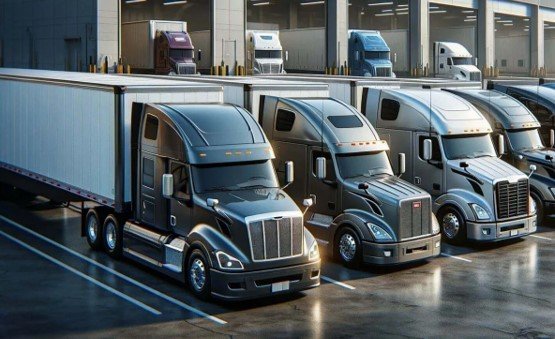Subtotal $0.00
Recently, the California Air Resources Board (CARB) withdrew its request for a waiver to the Environmental Protection Agency (EPA) to enforce the Advanced Clean Fleet (ACF) rule. The ACF placed the burden on fleets to purchase zero-emission vehicles (ZEVs) as a percentage of their new truck acquisitions. This decision has sparked numerous questions regarding the future of battery electric vehicles (BEVs) and hydrogen fuel cell electric vehicles (FCEVs). Will this action slow the deployment of these technologies? Will dealers still face challenges selling BEVs while potentially facing limitations on internal combustion engine (ICE) vehicle sales? And will it put an end to the controversial practice of “ratio-ing”?
Understanding the Advanced Clean Fleet Rule
The ACF required fleets with 50 or more vehicles or $50 million in revenue to purchase a specific percentage of ZEVs when acquiring new vehicles. This regulation was set to take effect in 2024, with a phased approach that increased ZEV purchase requirements over time. By 2042, all new purchases were expected to be ZEVs. Specific fleets, such as drayage operators, were mandated to have 100% ZEV purchases as early as 2025, while state municipalities faced a 50% requirement through 2026, increasing to 100% in 2027.
Unlike the Advanced Clean Truck (ACT) rule, which is broader in scope, the ACF applied to a relatively small segment of fleets—approximately 8% of U.S. trucking companies. However, these fleets operate a significant portion of commercial vehicle miles. Additionally, ACF was unique to California, whereas ACT has been adopted by multiple states through a memorandum of understanding. Importantly, ACF did not dictate the purchase of specific vehicle classes. Fleets could fulfill their ZEV obligations by acquiring a mix of yard trucks, vans, or other Group 1 vehicles.
Historically, emissions regulations have targeted original equipment manufacturers (OEMs) and engine manufacturers. ACF marked a shift by placing regulatory demands directly on fleet operators. With its withdrawal, questions arise about the continued momentum of ZEV adoption.
The Impact of ACF’s Withdrawal on BEV Deployment
Despite ACF’s withdrawal, BEVs and FCEVs remain integral to future transportation strategies. Other regulations, such as the ACT rule, EPA Greenhouse Gas (GHG) Phase 3 standards, the EPA 2027 Low NOx rule, and California’s Warehouse rule, continue to drive ZEV adoption. Additionally, economic incentives and operational cost benefits contribute to BEV viability.
Advanced Clean Truck (ACT) Rule and Its Implications
Unlike ACF, ACT directly targets OEMs, requiring a percentage of new truck sales to be ZEVs. By 2025, 11% of medium-duty trucks (Class 4-8 vocational) and 7% of heavy-duty tractors (Class 7 and 8) must be ZEVs. These quotas apply in states that have adopted ACT, compelling OEMs and their dealers to meet these targets.
Dealer Challenges and the Practice of “Ratio-ing”
Even without ACF, ACT has introduced complexities for OEMs and dealers. One such challenge is “ratio-ing,” a practice where manufacturers require dealers to maintain a specific ZEV-to-ICE sales ratio. For example, in 2025, an OEM must ensure that one out of every nine medium-duty trucks sold is a ZEV. If this quota is unmet, manufacturers may need to apply credits, restrict ICE vehicle sales, purchase credits from compliant manufacturers, or adjust pricing strategies to incentivize ZEV purchases.
Recent developments illustrate these pressures. Daimler Truck North America briefly paused ICE sales in Oregon due to regulatory credit concerns before resuming in mid-January. However, OEMs still face sales limitations in states enforcing ACT. Volvo, for instance, continues to restrict ICE sales to comply with ACT mandates.
Potential Delays or Modifications to ACT
Industry stakeholders speculate that ACT may face delays or adjustments due to high costs, infrastructure constraints, and legal challenges. While modifications are possible, major OEMs have committed to adhering to ACT through the Clean Truck Partnership agreement. Should OEMs withdraw from this commitment, CARB could reconsider its alignment with EPA regulations, potentially revisiting stricter NOx emission rules.
Additional Regulatory Drivers of ZEV Adoption
Beyond ACT, OEMs and engine manufacturers must navigate additional regulations such as GHG Phase 3 and EPA 2027 Low NOx. To meet stringent CO2 reduction targets, OEMs may integrate aerodynamic improvements, low rolling resistance tires, and powertrain advancements. However, given the magnitude of required emissions reductions, a mix of BEVs and ICE vehicles—or even hybrid options—may be necessary.
While the EPA 2027 Low NOx rule does not directly address greenhouse gas emissions, it mandates additional diesel engine components, increasing vehicle costs and narrowing the total cost of ownership (TCO) gap between ICE vehicles and BEVs. Furthermore, state-level warehouse rules are expected to accelerate ZEV adoption, particularly for yard tractors.
The Road Ahead for Fleets and ZEV Adoption
The withdrawal of ACF has eased regulatory burdens on fleets, particularly in drayage operations. However, numerous state and federal policies continue to incentivize ZEV adoption. Additionally, some fleets are voluntarily investing in BEVs due to projected long-term cost savings and environmental commitments.
As the trucking industry grapples with the financial and logistical challenges of BEV deployment, collaboration is essential. Policymakers, manufacturers, and fleet operators must work together to reduce costs, improve charging infrastructure, and explore alternative fuels. By addressing these barriers, the industry can progress toward a cleaner and more sustainable future while ensuring economic viability for all stakeholders.


